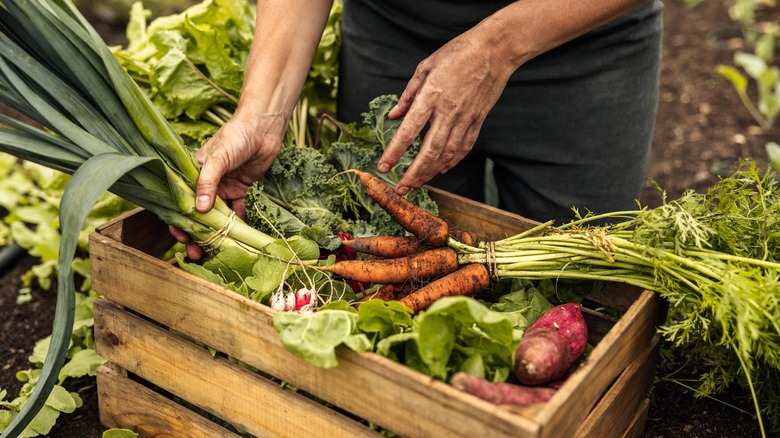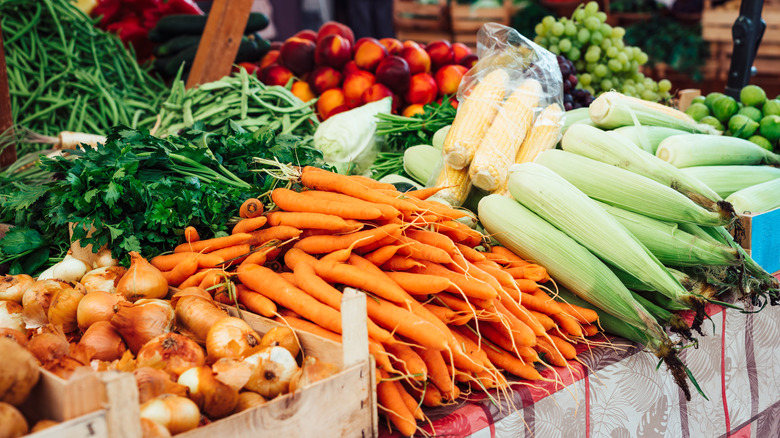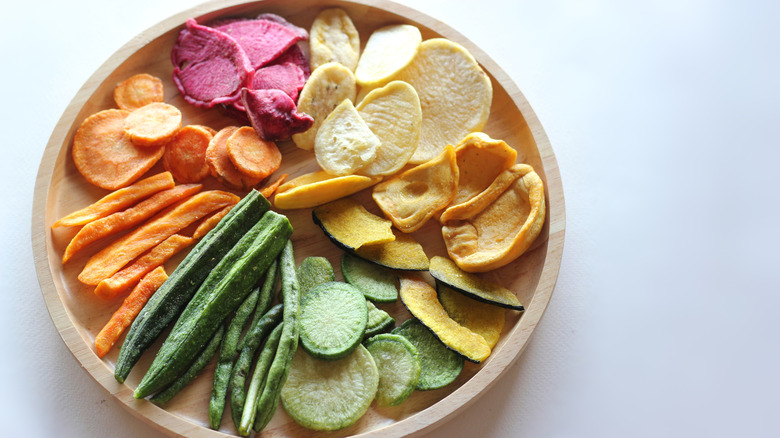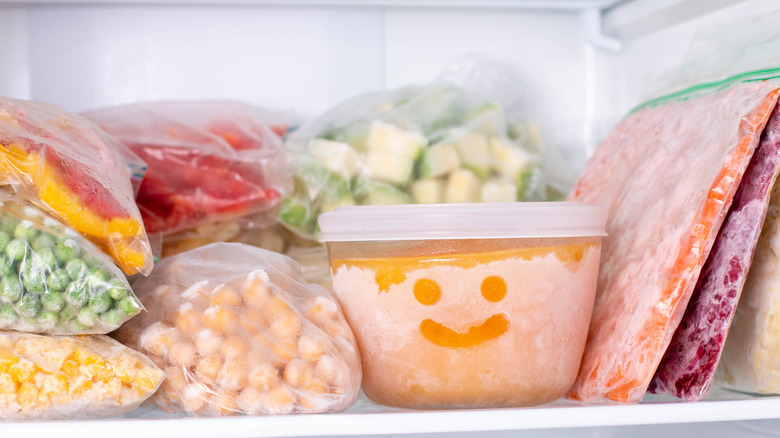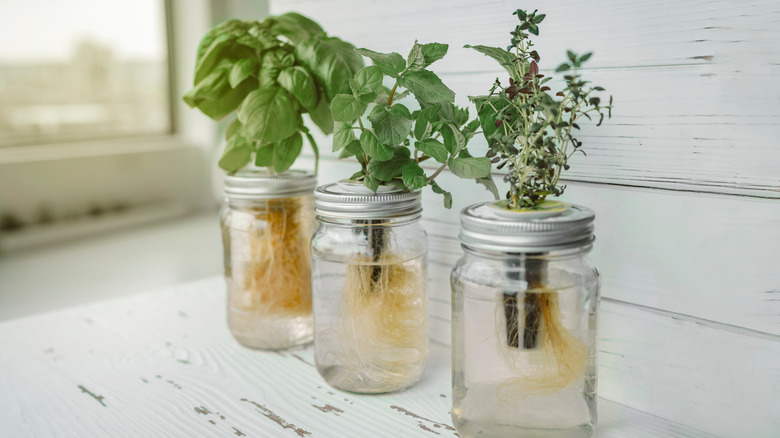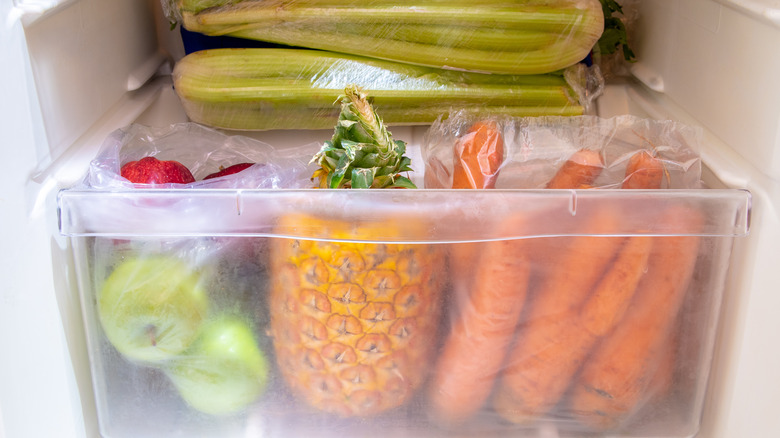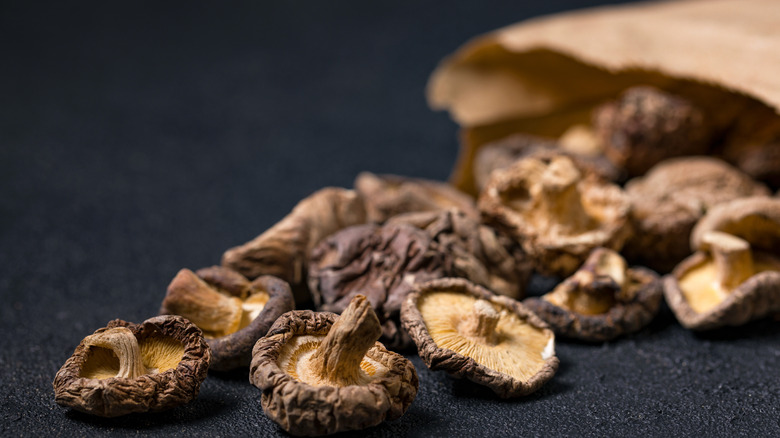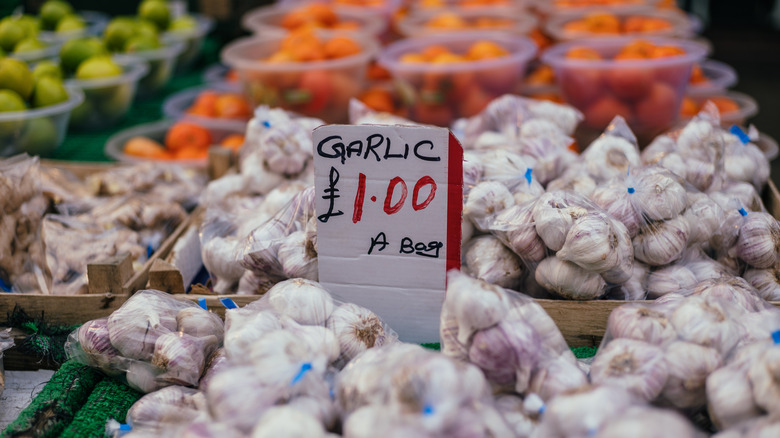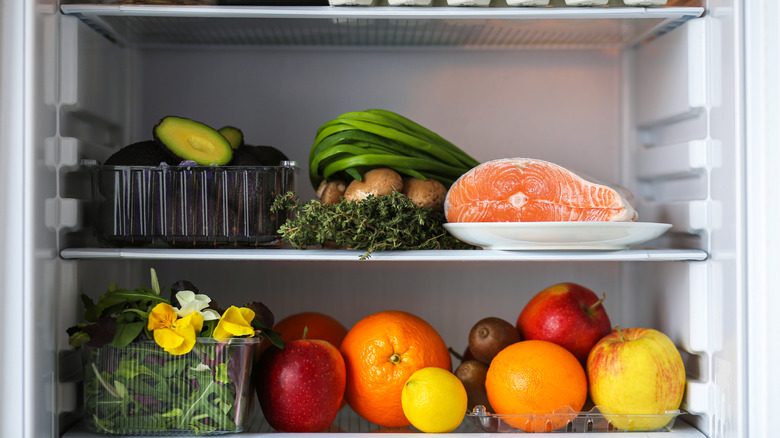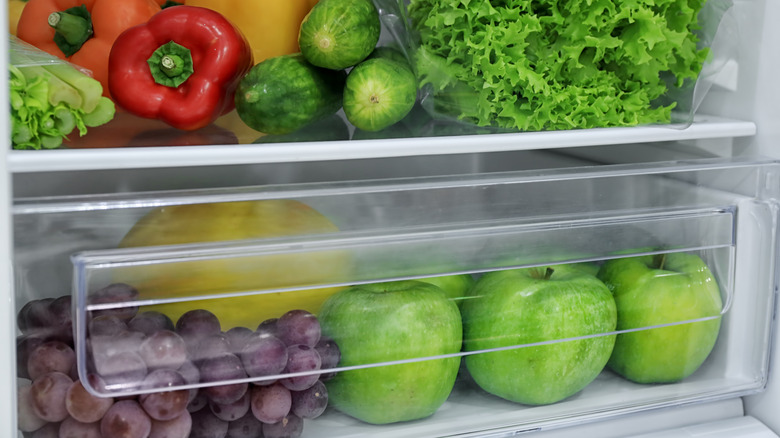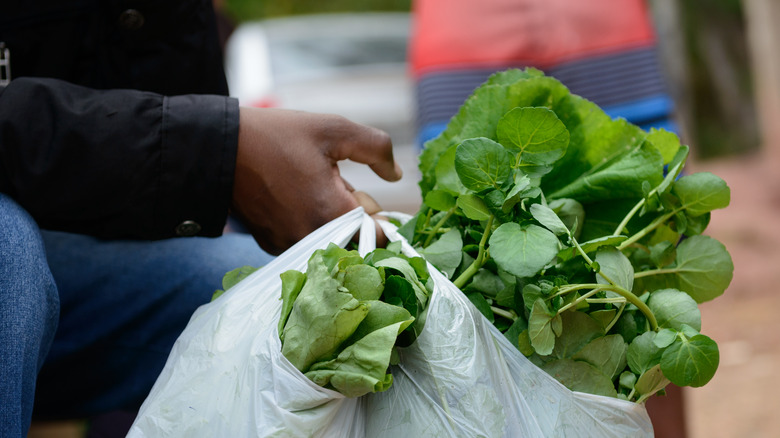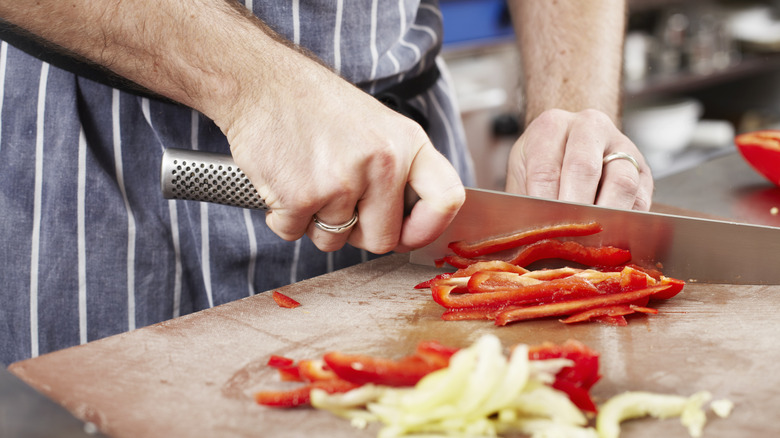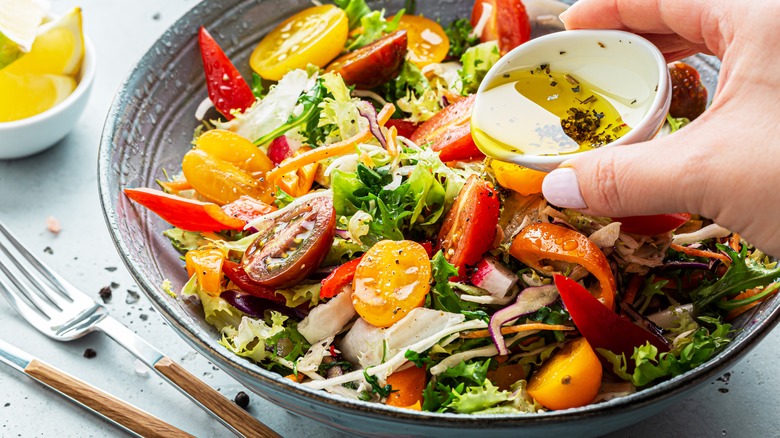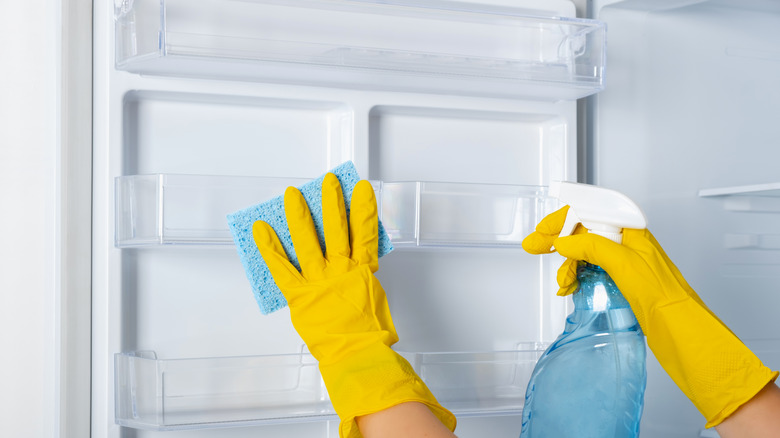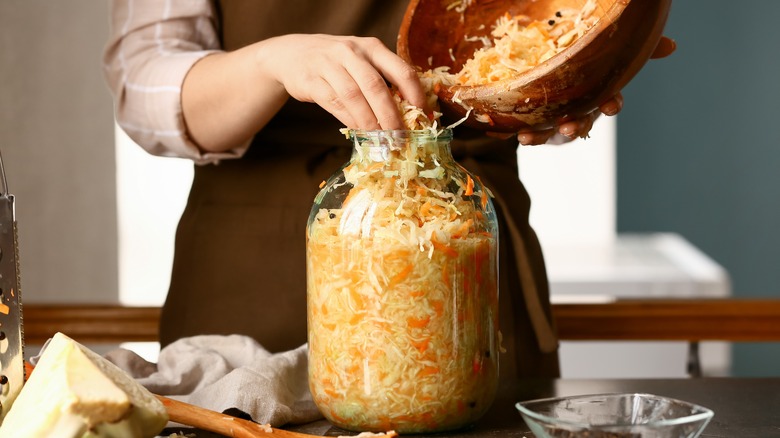14 Tips For Keeping Vegetables Fresher Longer
It's always frustrating when you're all set to make a great meal — maybe with a special recipe in mind — and you open up your fridge only to find that the produce you were planning to use has gone bad. It can be discouraging in the moment, and probably feels economically and materially wasteful.
You may also find yourself wondering if there's something you could've done differently. Would purchasing a different head of cabbage or another type of mushroom have made a difference? Or is there another method of storage that might've helped your produce last?
Produce is by definition perishable, and sometimes, it's just bad luck or unfortunate timing that leads it to go bad before you can use it. That said, there are still a number of ways you can intervene to keep vegetables fresher for longer, and make it more likely that nothing gets slimy or moldy before you're about to use it. With that in mind, read on for 14 tips on maximizing vegetables' freshness.
Buy fresher produce
The first and perhaps most obvious tip when it comes to keeping vegetables fresher for longer: Buy fresher produce. Almost universally, the fresher your produce is to start, the longer it will last.
It's pretty intuitive why. If a vegetable was harvested more recently, it's spent less time in shipping (including in potentially sub-optimal environments), had fewer opportunities to get bruised and damaged, and had less time to degrade in quality and taste. Consider the difference between an apple picked and eaten right off the tree in an orchard, and one that's been sitting on a grocery store shelf after being transported for days or longer: The gulf in taste is almost always obvious.
And so in general, trying to find fresher produce is always a good idea. Sometimes this can be hard at a grocery store, particularly a large, chain store that sources produce from across the country and world. This is one reason why vegetables from farmers markets are such a benefit. Such produce tends to be very fresh (unlike at grocery stores, vegetables are not routinely picked before they are ripe) and that freshness may be healthier due to higher levels of vitamins and nutrients.
Dehydrate vegetables
Even if you pick the freshest produce in the world and store it as carefully as possible (more suggestions on that below), all produce has an expiration date. Vegetables are organic, and every item — from the hardiest root vegetable to the most tender fruit — will go bad eventually.
Fortunately, there are a couple of ways to substantially extend the shelf life of vegetables, and one of them is dehydration. Dehydration, in general, refers to removing water from foods. Some foods, like certain fruits, greens, herbs, and possibly others, can be dehydrated simply with sun and air (and sufficient time).
But for other foods, or to speed up or make more uniform the process, an oven or electric food dehydrator is extremely handy. Dehydrators have myriad uses, and drying vegetables is only one of them. Potatoes, tomatoes, leafy greens, mushrooms, and much more can be conveniently dried with such an appliance. Such foods can be stored for months or even longer, and can be used for both solo eating and in more complex dishes.
Blanch and freeze veggies
Dehydration is a handy method for preserving vegetables, but another, perhaps more commonly practiced, is freezing. This technique can also help preserve fresh produce in the freezer for months or longer, and is safe and reliable — provided your freezer maintains a consistent temperature at 0° F, which also helps maintain the food's flavor and quality.
With vegetables, it's often helpful to blanch foods before freezing, which helps them retain quality, nutrients, and appearance over long periods of time being frozen. There are a couple of ways to blanch vegetables, but probably the most common is very briefly boiling them in water before transferring them to an ice water bath. The time period varies from vegetable to vegetable, but the key sign that they have boiled sufficiently is brightening in color, after which you will transfer them to an ice bath. Done properly, this will inhibit enzyme activity in a given vegetable, allowing for long-term frozen storage.
Store some vegetables in water
Assuming you've gotten the freshest produce you're able to find, and you don't plan to freeze or dehydrate it, the question is how best to store it fresh — and the answer isn't always as simple as sticking it right in the fridge, as is.
One useful technique, for some vegetables, is to store them in water. Depending on the particular item, this can mean either in or out of the fridge. Some leafy greens, like kale, collards, and chard, will do well with their ends trimmed, stuck in a glass of water in the fridge (and ideally, covered with a plastic bag). This technique will also help spruce up greens that have started to wilt. A similar technique works well when storing asparagus.
If you're storing freshly bought (or cut) herbs, with roots attached, doing more or less the same thing — trimming the bottoms and sticking the plant in water — is also ideal for storage. But keep more tender herbs on the counter, not in the fridge.
Use the crisper drawer wisely
When it comes to storing veggies in the fridge, it's important to use the crisper drawer effectively. The crisper drawer, which has a sometimes-adjustable humidity setting, is supposed to be used for fresh produce but takes some consideration to be sure it's having the intended effect.
First, it is important to note that some crisper drawers can be set for high or low humidity, and the setting makes a difference in terms of what's best stored in them. Vegetables that can lose moisture quickly — like thin-skinned and leafy vegetables, among others — naturally do well in a high-humidity drawer. On the other hand, ethylene-producing fruits (like apples, melons, and many others) do better in a low-humidity drawer, which can slow down the ripening process.
It is also important not to overfill the crisper drawer. Airflow is always key, and packing in too much can damage vegetables.
Store mushrooms in paper bags
Mushrooms are obviously a very particular type of produce, and unsurprisingly, require some specific care. The biggest thing, with mushrooms, is to avoid storing them in plastic bags. Mushrooms contain more water than other types of vegetables (and of course, are themselves not technically a vegetable). This can lead them to spoil faster when in environments that trap humidity.
Unfortunately, as any mushroom buyer probably knows, these fungi are often sold on grocery store shelves in plastic-wrapped containers. In time, this can have a detrimental effect on mushrooms as moisture builds up in the container.
For more effective storage, a not-tightly-sealed paper bag is ideal. This will allow sufficient moisture to escape. If you can find loose mushrooms, packing them yourself in a paper bag is best. But if you have to buy them pre-packaged, be sure to transfer them to a paper bag as soon as you're home. It's also a good idea to put them outside the crisper drawer, to avoid additional humidity issues.
Know what to keep out of the fridge
While refrigerators are designed to keep produce and other foods fresher for longer periods of time, it's very important to remember that not everything should go in the fridge, and many types of produce should not. Potatoes, alliums, tomatoes, and a host of other veggies are best kept non-refrigerated, more or less at room temperature.
The reasons for doing so depend, to some degree, on the particular vegetable. Garlic, for instance, will be more prone to sprout if kept in the fridge. Tomatoes, on the other hand, will lose quality in flavor and texture as they are refrigerated.
This said, that doesn't mean onions, garlic, potatoes, tomatoes, and other items can go anywhere. In general, storing them in a cool, dry place (out of the sun) is best. Other techniques, like storing tomatoes stem-down, can also be helpful in maintaining freshness.
Separate veggies from fruits
As mentioned above, a number of fruits — including apples, avocados, bananas, peaches, pears, peppers, and more — give off a gas called ethylene, which causes them to ripen faster. Ethylene production is a fascinating process and is integral to effectively ripening a given piece of fruit. However, ethylene gas can have side effects on a number of fruits (and vegetables) that are particularly sensitive to the gas. It's a long list, but it includes asparagus, broccoli, collard greens, cucumbers, onions, sweet potatoes, and other items that will ripen prematurely if exposed to ethylene gas. If you store broccoli next to peaches, for instance, that broccoli will be more likely to turn yellow faster.
While it can be hard to memorize the whole list, usually that's not necessary. Just be sure to separate fruits and vegetables in the fridge. Also be mindful that any ethylene-producing produce can potentially ripen too fast if stored in a sealed container, as the gas gets trapped in.
Don't overfill the refrigerator
There are a few good rules of thumb when keeping anything fresh, and one is this: avoid overcrowding. This is particularly true in the fridge. After a big grocery shop, or even a good harvest from the home garden, it may seem imperative to shove everything into the refrigerator to make it fit and to keep items cool. But produce needs to breathe. Packing too much into the refrigerator in the hopes of properly cooling it can quickly backfire. Cold air can get trapped in certain parts of your fridge, leading items to get overly cold, or in some cases, even partially freeze. Alternatively, other items may not be sufficiently refrigerated and may spoil faster. The process can obviously snowball, ultimately leading to food loss.
Be mindful of space, and focus on creating an appropriately organized fridge for the most benefit for your food.
Be mindful of packaging
There is no one rule when it comes to how best to package produce. Some tips have been suggested above (store mushrooms in paper bags, don't store certain items in the refrigerator, and so on). But speaking more generally, some produce is best kept in its original packaging, while other items should be removed and repackaged.
In general, there are a few good rules of thumb to follow. One is that whole vegetables will stay fresher longer than cut ones, so if you decide to buy something pre-cut, use it fast! Another is that space and airflow are important. For instance, greens will last longer if not banded together, and do well in a bag with some holes to let them breathe. Some items need extra moisture. Herbs with the root attached do well on the counter in a glass of water, but a packaged herb bundle will probably last longest wrapped in a wet paper towel.
In general, try to use common sense, stay organized, and pay attention so mistakes can be avoided in the future.
Don't prep vegetables until you're using them
As noted, cut vegetables and fruits are bound to go bad faster than whole produce items. Of course, sometimes it's more convenient to buy something pre-cut — like pieces of fruit, if you're throwing a party, or butternut squash cubes, if you don't want to go through the trouble of peeling and slicing an entire squash. Just bear in mind: If you do go the pre-cut route, you'll have to use items more quickly.
Whole fruits and vegetables, on the other hand, will allow for more flexibility. While everything has a shelf life, you will have a little more time to use a given item when you want to. Washing is another factor in this. Cleaning produce is essential, but cleaning it too early and leaving it wet can contribute to problems like mold.
One thing to note is that with root vegetables with greens attached, like carrots, it's important to remove the greens before storage, as they will wilt quickly and can contribute to the root vegetable drying out.
Use oldest produce first
If you've ever worked in a restaurant, you've probably heard the acronym FIFO, or something similar. FIFO stands for "first in, first out" and serves as a reminder to rotate food and use older items first.
This is a pretty effective practice in home kitchens, too, and a helpful way to ensure produce stays fresh and is used in as ideal a range of time as possible. It can be a good idea to make a habit of rotating produce, particularly in the fridge, where things can quickly get buried: Bring older items to the front, and put the new produce you purchase behind it. As mentioned, every piece of produce inevitably has an expiration date — eventually. In some cases, the most effective way to extend that range is to plan your vegetable use wisely.
Another helpful tip alongside using older produce first? Try planning your meals. That way, you can have a set plan for using your vegetables, and avoid waste.
Clean the fridge regularly
There's another handy tip that can help alongside regular rotation: Keep things tidy. Just because a refrigerator keeps things cold doesn't mean it can't get pretty gross. A clean refrigerator will inhibit mold growth, improve airflow, and generally allow you to stay on top of effective veggie organization. Naturally, it'll also help produce last longer, as the risk of contamination will be significantly decreased
Cleaning your fridge can also help in more acute cases, like in the event of a food recall. In such cases, the CDC recommends throwing out the recalled food and any food stored with it, and temporarily emptying your fridge of other food. Then, you'll want to take out all drawers and shelves and clean those and the fridge interior with hot, soapy water. After drying it with a clean towel, the CDC recommends using a diluted bleach solution to thoroughly sanitize the inside of the fridge.
Process vegetables
There's one last way of helping vegetables last longer — and that's by preserving them. Freezing and dehydrating have already been covered, but vegetables can also be preserved through canning, fermentation, and pickling. All methods are a little different, and some techniques work well for different veggies. But all methods of preservation allow for potentially long-term, shelf-stable ways of keeping vegetables fresh and healthy.
Pickling is a pretty easy place to start, in part because so-called "refrigerator pickles" can be made without much risk and a relatively simple technique. You simply make a brine (usually water, vinegar, and pickling spices) and pour it over prepared vegetables (cucumbers are popular, but pretty much anything works). These can then be stored safely in the refrigerator.
Making shelf-stable foods is a little more complicated. Fermentation — like what's done to make sauerkraut — involves the anaerobic breakdown of molecules like glucose by microorganisms, while canning creates an oxygen-free environment to prevent bacterial and other growths and preserve food. Both methods are safe if done correctly, but it's important to closely follow reputable directions, such as those from the National Center for Home Food Preservation.
